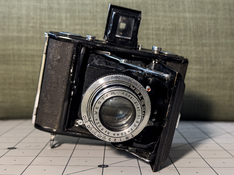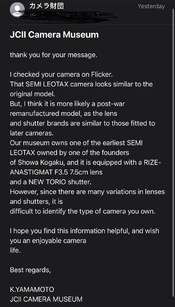RestlessReel
Member
Good morning!
I was doing some reading today about an old occupied Japan camera that my great grandfather had.
It is a Shoya Kogaku Semi Leotax with a Wester 75mm Anastigmat lens.
I was hoping someone might be able to help me further identify it.
The Camera wiki claims that there are no known samples of the original model which had a manual film key and 2 red windows on the back. This one has these things and does not appear to be the newer version, as those only had one red window in the back.
Thank you!
I was doing some reading today about an old occupied Japan camera that my great grandfather had.
It is a Shoya Kogaku Semi Leotax with a Wester 75mm Anastigmat lens.
I was hoping someone might be able to help me further identify it.
The Camera wiki claims that there are no known samples of the original model which had a manual film key and 2 red windows on the back. This one has these things and does not appear to be the newer version, as those only had one red window in the back.
Thank you!







